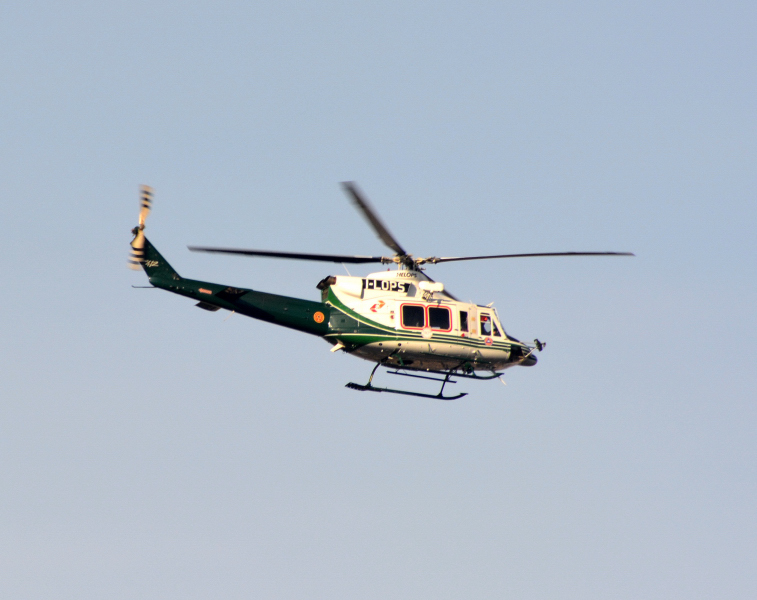A concise technical and professional overview of the Bell 412 helicopter, a twin-turbine multirole aircraft developed by Bell Helicopter (now part of Textron). The information presented here is general in nature; for exact performance data, operating procedures, and regulatory requirements, please consult the official manufacturer’s documentation and authoritative technical publications.

1. Introduction and Background
The Bell 412 is a medium-class, four-blade helicopter derived from the successful Bell 212/205 series. It made its commercial debut in the early 1980s and remains one of Bell’s most versatile and widely used models in both civil and government sectors. Operators value its reliability, spacious cabin, and multirole capabilities that span passenger transport, emergency medical services (EMS), firefighting, search-and-rescue (SAR), and various military applications.
- First Flight: 1979 (as a development prototype from the Bell 212).
- Entry into Service: Early 1980s.
2. Design and Structure
Fuselage
- Optimized for a balanced mix of payload capacity, agility, and stability.
- Large sliding doors allow flexible cabin configurations, whether for passenger seating, stretchers, or mission-specific equipment.
Main Rotor
- Four-blade design (composite materials in newer variants) offers improved lift, reduced vibration, and greater operational efficiency compared to earlier two-blade systems.
- Elastomeric bearings and advanced rotor hub design help extend component life and reduce maintenance overhead.
Tail Rotor
- Typically a conventional two-blade tail rotor (some variants may feature a four-blade tail rotor), with a gearbox engineered to lower noise and mechanical stress.
Landing Gear
- Standard skid-type landing gear for most civil variants.
- Certain military or specialized variants can be fitted with fixed or retractable wheeled landing gear kits.
3. Powerplant and Systems
Propulsion
- Most Bell 412s are powered by a Pratt & Whitney Canada PT6T “Twin-Pac” engine configuration (two power turbines coupled to a single gearbox).
- Common engine models: PT6T-3D, PT6T-3BE, or subsequent upgrades depending on variant and production year.
Indicative Performance (standard configuration, ISA conditions*)
- Overall Power: Approximately 1,800–1,900 shp (shaft horsepower) available, governed for optimal performance and safety margins.
- Cruise Speed: ~220–230 km/h (120–125 knots).
- Range: Up to ~600–700 km (about 3 hours endurance), depending on payload, fuel tank configuration, and mission profile.
- Service Ceiling: Around 20,000 ft (6,100 m); hover ceilings are notably lower depending on weight and density altitude.
*ISA: International Standard Atmosphere (15 °C at mean sea level, 1013.25 hPa).
Fuel System
- Internal tanks located beneath or behind the cabin floor.
- External auxiliary tanks can be installed to increase range (often used for SAR or long-range patrol missions).
Electrical and Avionics
- Generators driven by each turbine (commonly 28 VDC and/or 115 VAC at 400 Hz in certain configurations).
- Modern variants and retrofitted models may feature “glass cockpit” digital avionics; older models typically retain analog instrument panels.
4. Capabilities and Configurations
Passenger Transport
- Accommodates up to 13 persons (including pilot and copilot), though configurations can vary from 9 to 15 seats depending on the certification and layout.
- VIP and corporate interiors can include upgraded seating, enhanced soundproofing, climate control, and additional amenities.
SAR/EMS (Search and Rescue / Emergency Medical Service)
- Spacious cabin suitable for stretchers, medical equipment, and medical personnel.
- Optional external hoist system with varying lift capacities.
- Large sliding doors facilitate loading/unloading operations.
Firefighting
- Can carry a Bambi Bucket or internal/underslung tanks for water or fire retardant drops.
- Good maneuverability in mountainous or high-temperature conditions, depending on available engine power.
External Load (Cargo Hook)
- Provision for a belly-mounted cargo hook capable of lifting external loads (up to ~2,000 kg, depending on the variant and operational limitations).
5. Major Variants and Designations
- Bell 412EP (Enhanced Performance): Upgraded performance and avionics.
- Bell 412HP (High Performance): Similar enhancements with differences in powerplant or mission equipment.
- Bell 412EPI: Further modernized variant featuring a fully digital cockpit, FADEC (Full Authority Digital Engine Control), and additional aerodynamic refinements.
- AB 412: Agusta-Bell–licensed production in Italy (now under Leonardo), often with localized military/civil adaptations.
- CH-146 Griffon: A Canadian Forces designation based on the Bell 412 platform, featuring specialized avionics, sensors, weapons mounts, and mission systems.
6. Operational Roles
Military and Paramilitary
- Used for troop transport, casualty evacuation (MEDEVAC), reconnaissance, and surveillance.
- Can be equipped with sensor turrets, door guns, and electronic countermeasures in certain configurations.
Civil and Government
- Mountain rescue, coast guard patrol, VIP transport, pipeline/power-line inspections.
- Widely employed by civil defense and firefighting agencies worldwide.
Offshore
- Serves in oil and gas transport roles to offshore platforms, thanks to its reliable twin-engine design and maritime operating certifications.
7. Maintenance and Support
- Maintenance Manuals: Issued by Bell Textron, covering required procedures and inspections to maintain airworthiness.
- Inspection Programs: Periodic checks (e.g., 100-hour, 300-hour, 600-hour intervals, and calendar-based inspections) along with scheduled component replacements (transmission, rotor systems, engines).
- Upgrades and Retrofits: May include avionics modernization (glass cockpit), self-defense suites, engine upgrades for improved hot-and-high performance, and various mission-specific equipment packages.
8. Conclusion
The Bell 412 has established itself as a benchmark medium twin-engine helicopter, prized for its reliability, versatility, and solid performance across multiple mission profiles. Its robust airframe, numerous variant options, and comprehensive aftermarket support have fostered global adoption by civil, government, and military operators.
Nonetheless, achieving the highest levels of safety and operational readiness requires strict adherence to maintenance procedures, manufacturer updates, and regulatory compliance. Proper crew training and experience are equally crucial to fully leverage the aircraft’s capabilities and ensure success in demanding flight operations.
![]() BELL 412
BELL 412 


